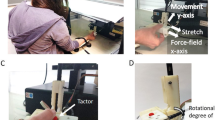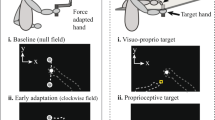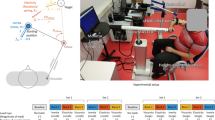Abstract
When manipulating objects, our sensorimotor system integrates information from multiple sensory streams. An important stream is the force information that is sensed by two modalities in our body – kinesthetic and tactile. In this study, we examined the integration between kinesthetic and tactile information during adaptation to a force perturbation. We exposed participants who performed reaching movements toward targets to a velocity-dependent force field. For one of the groups, we added artificial tactile stimulation by stretching the skin of their fingertips in the same direction of the applied force. We found no difference between the kinematics of two groups, but the skin-stretch affected their manipulation and grip forces. These results suggest that tactile and kinesthetic information may have distinct mechanisms of integration with kinematic states during force field adaptation.
This study is supported by US-Israel Binational Science Foundation (grant 2016850), ABC Robotics Initiative, Ministry of Science and Technology, Israel (Joint Israel-Italy lab in Biorobotics “Artificial somatosensation for humans and humanoids”) and Besor Fellowship (CA).
Access provided by Autonomous University of Puebla. Download conference paper PDF
Similar content being viewed by others
Keywords
These keywords were added by machine and not by the authors. This process is experimental and the keywords may be updated as the learning algorithm improves.
1 Introduction
In everyday interaction with objects, we must concurrently control and sense position and force for estimating the mechanical properties of the manipulated objects, and for appropriate coordinating actions such as handling a tool. When interacting with objects, we control manipulation and grip forces as a response to the external load that is applied by the object. Manipulation forces are the forces and torques that we exert against the held object to translate and rotate it. In contrast, grip forces stabilize the grasped object to prevent its slippage without resulting in any motion [1, 2].
We have two force sensing modalities – kinesthetic and tactile. Kinesthetic force information is sensed by tension of the muscles and Golgi tendon organs, and tactile information is sensed by the mechanoreceptors of the skin. Recently, new devices were developed that can stimulate the tactile mechanoreceptors in the skin [3, 4] augment perception of stiffness [5, 6] and friction [7], and even improve balance and posture in healthy adults [8]. However, except from a study that showed that tactile stimulation does not affect the kinematics during force field adaptation [9], the contribution of skin-stretch to force field adaptation was not studied.
We examined the effect of adding an artificial skin-stretch during adaptation to a force perturbation. By adding artificial stretch, we aimed to model the contribution of tactile information to force estimation, and hypothesized that the added information will facilitate faster adaptation.
2 Materials and Methods
We modified a custom-built skin-stretch device with an embedded force sensor from [6] such that the skin-stretch was applied in the horizontal plane. We attached the device to a robotic arm, and together, they could apply force on the hand of the participants and an additional tangential skin stretch on the thumb and index finger of the participants (Fig. 1A).
Sixteen right-handed healthy participants took part of the study that was approved by the Human Participants Research Committee of Ben-Gurion University of the Negev, Be’er-Sheva, Israel. The experiment was composed of three sessions: baseline, adaptation and washout. In the baseline and washout sessions, participants performed reaching movements without perturbations. In the adaptation session, we exposed participants (N = 8) to a velocity-dependent force-field perpendicular to the movement direction (Fig. 1B, red line). A second group (N = 8), in addition to the force field, experienced a velocity-dependent skin-stretch in the same direction of the applied force (Fig. 1B, blue line). During the experiment, we embedded force-channel trials, in which the haptic device applied virtual walls that constrained the movement to be straight (Fig. 1C). These trials enabled us to examine the manipulation forces that the participants apply throughout adaptation.
3 Results
Both groups exhibited a typical baseline, adaptation and washout patterns of deviation from straight line. To quantify kinematics error we calculated the maximal deviation perpendicular to movement direction. A two-way mixed ANOVA with between factor of group and within factor of stage showed no difference between the deviations of the two groups (F1, 14 = 0.002, p = 0.965. Fig. 2). However, the skin-stretch affected their manipulation (Fig. 3) and grip forces (Fig. 4). During early adaptation, the correlation coefficients between the manipulation forces in the force channel trial and the load forces in the preceding trial was smaller in the group with skin-stretch (average of five first trials: 0.395 with skin stretch and 0.684 without skin-stretch, Fig. 3C), suggesting that the skin-stretch deteriorated adaptation. With continued adaptation, the participants gained similar performances as the group without skin-stretch (t14 = 0.068, p = 0.946).
The effect of adaptation on the manipulation forces with and without skin-stretch. (A) Average (line) and SE (shaded region) of the manipulation forces (MF, solid line) applied in the first force channel in the adaptation session, and the load forces (LF, dashed line) from the preceding trial for the group with (blue) and without (red) skin-stretch. (B) Same as (A) for the last force channel in the adaptation session. (C) Correlation coefficient between manipulation forces and load forces in preceding trial for the groups with (blue) and without (red) skin-stretch. Shaded region represents standard error.
The effect of adaptation on the grip forces with and without skin-stretch. (A) Same as Fig. 3A but for grip forces (GF, solid line) (B) Same as (A) for the last force channel in the adaptation session. (C) Peak-ratio between load forces and grip forces for the groups with (blue) and without (red) skin-stretch. Shaded region represents standard error.
In addition, we saw that throughout adaptation, the grip forces were larger in the presence of skin-stretch. Therefore, we calculated the peak ratio between the grip force and load force (Fig. 4C). The applied grip forces per amount of load forces for the group with skin-stretch were higher even at the end of adaptation (t14 = 2.322, p < 0.05).
4 Discussion
Additional skin-stretch information increased the applied grip force. Surprisingly, the skin-stretch also had initial deteriorating effect on the adaptation process. This was demonstrated in decreasing of the correlation between the manipulation and the load forces. Together with the unaffected trajectories, we suggest that this lack of adaptation could be compensated by increasing arm stiffness.
5 Conclusion
Understanding tactile and kinesthetic information integration is important for developing new rehabilitation techniques and especially wearable devices for somatosensory rehabilitation and assistance. In addition, using tactile stimulation, it is possible to present users of prosthetic devices with force information. We present a preliminary investigation on how the human sensorimotor system combines kinesthetic and tactile information in force field adaptation. Further investigation is needed to understand how kinesthetic and tactile stimulation can be efficiently combined for rehabilitation purposes.
References
Kuschel, M., Di Luca, M., Buss, M., Klatzky, R.L.: Combination and integration in the perception of visual-haptic compliance information. IEEE Trans. Haptics 3(4), 234–244 (2010)
Leib, R., Karniel, A., Nisky, I.: The effect of force feedback delay on stiffness perception and grip force modulation during tool-mediated interaction with elastic force fields. J. Neurophysiol. 113(9), 3076–3089 (2015)
Prattichizzo, D., Pacchierotti, C., Rosati, G.: Cutaneous force feedback as a sensory subtraction technique in haptics. IEEE Trans. Haptics 5(4), 289–300 (2012)
Schorr, S.B., Okamura A.: Three-dimensional skin deformation as force substitution: Wearable device design and performance during haptic exploration of virtual environments, IEEE Trans. Haptics (2017)
Quek, Z.F., Schorr, S.B., Nisky, I., Okamura, A.M., Provancher, W.R.: Augmentation of stiffness perception with a 1-degree-of-freedom skin stretch device. IEEE Trans. Hum.-Mach. Syst. 44(6), 731–742 (2014)
Farajian, M., Leib, R., Zaidenberg, T., Mussa-Ivaldi, F., Nisky, I.: Stretching the skin of the fingertip creates a perceptual and motor illusion of touching a harder spring, bioRxiv, 203604 (2017)
Provancher, W.R., Sylvester, N.D.: Fingerpad skin stretch increases the perception of virtual friction. IEEE Trans. Haptics 2(4), 212–223 (2009)
Pan, Y., Yoon, H.U., Hur, P.: A portable sensory augmentation device for balance rehabilitation using fingertip skin stretch feedback. IEEE Trans. Neural Syst. Rehabil. Eng. 25(1), 31–39 (2017)
Rosati, G., Oscari, F., Pacchierotti, C., Prattichizzo, D.: Effects of kinesthetic and cutaneous stimulation during the learning of a viscous force field. IEEE Trans. Haptics 7(2), 251–263 (2014)
Author information
Authors and Affiliations
Corresponding author
Editor information
Editors and Affiliations
Rights and permissions
Copyright information
© 2019 Springer Nature Switzerland AG
About this paper
Cite this paper
Avraham, C., Nisky, I. (2019). Integration of Kinesthetic and Tactile Information for Manipulation and Grip Force Control During Force-Field Adaptation. In: Masia, L., Micera, S., Akay, M., Pons, J. (eds) Converging Clinical and Engineering Research on Neurorehabilitation III. ICNR 2018. Biosystems & Biorobotics, vol 21. Springer, Cham. https://doi.org/10.1007/978-3-030-01845-0_205
Download citation
DOI: https://doi.org/10.1007/978-3-030-01845-0_205
Published:
Publisher Name: Springer, Cham
Print ISBN: 978-3-030-01844-3
Online ISBN: 978-3-030-01845-0
eBook Packages: EngineeringEngineering (R0)








